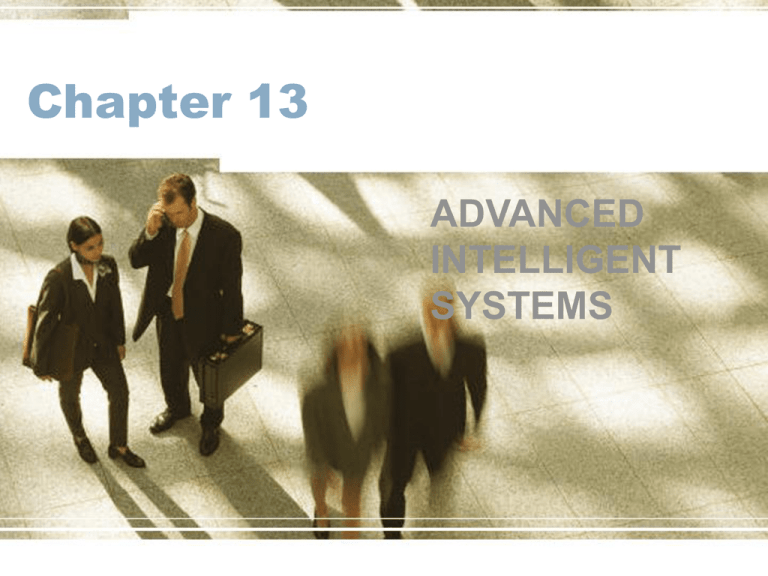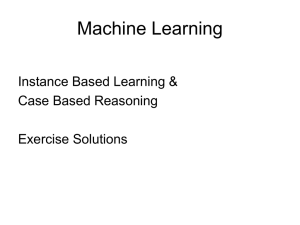Case-Based Reasoning (CBR) - Faculty Personal Web Page
advertisement

Chapter 13 ADVANCED INTELLIGENT SYSTEMS Learning Objectives • Understand machine-learning concepts • Learn the concepts and applications of case-based systems • Understand the concepts and applications of genetic algorithms • Understand fuzzy set theories and their applications in designing intelligent systems Learning Objectives • Understand the concepts and applications of natural language processing (NLP) • Learn the concepts, advantages, and limitations of voice technologies • Learn about integrated intelligent support systems Machine-Learning Techniques • Machine-learning concepts and definitions – Machine learning The process by which a computer learns from experience (e.g., using programs that can learn from historical cases) Machine-Learning Techniques – Human learning is a combination of many complicated cognitive processes including: • Induction (learning by example) • Deduction (specific inferences based on generalities) • Analogy (transference) • Other special procedures related to observing or analyzing examples Machine-Learning Techniques – How learning relates to intelligent systems • Learning systems demonstrate interesting learning behaviors • AI is not able to learn as well as humans or in the same way that humans • Machine learning cannot be applied in a creative way, although such systems can handle cases to which they have never been exposed • It is not clear why learning systems succeed or fail • A common thread running through most AI approaches to learning is the manipulation of symbols rather than numeric information Machine-Learning Techniques • Machine-learning methods – Supervised learning A method of training artificial neural networks in which sample cases are shown to the network as input and the weights are adjusted to minimize the error in its outputs – Unsupervised learning A method of training artificial neural networks in which only input stimuli are shown to the network, which is self-organizing Machine-Learning Techniques Machine-Learning Techniques Machine-learning methods and algorithms • Inductive learning • Case-based reasoning • Neural computing • Genetic algorithms • Natural language processing (NLP) • Cluster analysis • Statistical methods • Explanation-based learning A machine learning approach that assumes that there is enough existing theory to rationalize why one instance is or is not a prototypical member of a class Case-Based Reasoning (CBR) • Case-based reasoning (CBR) A methodology in which knowledge and/or inferences are derived from historical cases Case-Based Reasoning (CBR) – Analogical reasoning Determining the outcome of a problem with the use of analogies. A procedure for drawing conclusions about a problem by using past experience Suppose, for example, that I am thinking about buying a new car. I'm very likely to speak with other people who have recently bought new cars, noting their experiences with various makes, models, and dealers. If I discover that three of my friends have recently bought Brand X from ABC Dealership and that all three have been delighted with their purchases, then I will conclude by analogy that if I buy Brand X from ABC Dealership, I will be delighted, too. – Evaluating Analogical Reasoning • Number of instances, instance variety, # of similarities, relevance, # of dissimilarities, modesty of conclusion Case-Based Reasoning (CBR) – Inductive learning A machine learning approach in which rules are inferred from facts or data Case-Based Reasoning (CBR) • The basic idea and process of CBR – Four-step process 1. 2. 3. 4. Retrieve Reuse Revise Retain Case-Based Reasoning (CBR) • Definition and concepts of cases in CBR – Ossified cases Cases that have been analyzed and have no further value – Paradigmatic cases A case that is unique that can be maintained to derive new knowledge for the future Case-Based Reasoning (CBR) • Definition and concepts of cases in CBR – Stories Cases with rich information and episodes. Lessons may be derived from this kind of cases in a case base Case-Based Reasoning (CBR) Case-Based Reasoning (CBR) • Benefits and usability of CBR – CBR makes learning much easier and the recommendation more sensible Case-Based Reasoning (CBR) • Advantages of using CBR – – – – – – – – Knowledge acquisition is improved. System development time is faster Existing data and knowledge are leveraged Complete formalized domain knowledge is not required Experts feel better discussing concrete cases Explanation becomes easier Acquisition of new cases is easy Learning can occur from both successes and failures Case-Based Reasoning (CBR) • Uses, issues, and applications of CBR – Applications • • • • • • • CBR in electronic commerce WWW and information search Planning and control Design Reuse Diagnosis Reasoning Case-Based Reasoning (CBR) • Uses, issues, and applications of CBR – Implementation issues for designers • What makes up a case? How can we represent case memory? • Automatic case-adaptation rules can be very complex • How is memory organized? What are the indexing rules? • The quality of the results is heavily dependent on the indexes used Case-Based Reasoning (CBR) – Implementation issues for designers • How does memory function in relevant information retrieval? • How can we perform efficient searching (i.e., knowledge navigation) of the cases? • How can we organize the cases? • How can we design the distributed storage of cases? • How can we adapt old solutions to new problems? Can we simply adapt the memory for efficient querying, depending on context? What are the similarity metrics and the modification rules? Case-Based Reasoning (CBR) – Implementation issues for designers • How can we factor errors out of the original cases? • How can we learn from mistakes? That is, how can we repair and update the case base? • The case base may need to be expanded as the domain model evolves, yet much analysis of the domain may be postponed. • How can we integrate CBR with other knowledge representations and inferencing mechanisms? • Are there better pattern-matching methods than the ones we currently use? • Are there alternative retrieval systems that match the CBR schema? Case-Based Reasoning (CBR) • Success factors for CBR systems 1. 2. 3. 4. Determine specific business objectives Understand your end users and customers Design the system appropriately Plan an ongoing knowledge-management process 5. Establish achievable returns on investment (ROI) and measurable metrics 6. Plan and execute a customer-access strategy 7. Expand knowledge generation and access across the enterprise Genetic Algorithm Fundamentals • Genetic algorithms (GAs) Software programs that learn in an evolutionary manner similar to the way biological systems evolve Genetic Algorithm Fundamentals • Genetic algorithm process and terminology – Chromosome A candidate solution for a genetic algorithm – Reproduction The creation of new generations of improved solutions with the use of a genetic algorithm Genetic Algorithm Fundamentals • Genetic algorithm process and terminology – Crossover The combining of parts of two superior solutions by a genetic algorithm in an attempt to produce an even better solution – Mutation A genetic operator that causes a random change in a potential solution Genetic Algorithm Fundamentals Genetic Algorithm Fundamentals – A few parameters must be set for the genetic algorithm • Number of initial solutions to generate • Number of offspring to generate • Number of parents and offspring to keep for the next generation • Mutation probability (very low) Genetic Algorithm Fundamentals – Limitations of genetic algorithms • Not all problems can be framed in the mathematical manner that genetic algorithms demand • Development of a genetic algorithm and interpretation of the results requires an expert who has both the programming and statistical/mathematical skills demanded by the genetic algorithm technology in use • In some situations, the “genes” from a few comparatively highly fit (but not optimal) individuals may come to dominate the population, causing it to converge on a local maximum Genetic Algorithm Fundamentals – Limitations of genetic algorithms • Most genetic algorithms rely on random number generators that produce different results each time the model runs • Locating good variables that work for a particular problem is difficult • Selecting methods by which to evolve the system requires thought and evaluation Developing Genetic Algorithm Applications • GAs are a type of machine learning for representing and solving complex problems Developing Genetic Algorithm Applications Applications of GAs include: • Dynamic process control • Induction of optimization of rules • Discovery of new connectivity topologies (e.g., neural computing connections, i.e., neural network design) • Simulation of biological models of behavior and evolution • Complex design of engineering structures • Pattern recognition • Scheduling • Transportation and routing • Layout and circuit design • Telecommunication • Graph-based problems Fuzzy Logic Fundamentals • Fuzzy logic Logically consistent ways of reasoning that can cope with uncertain or partial information; characteristic of human thinking and many expert systems. • Fuzzy sets A set theory approach in which set membership is less precise than having objects strictly in or out of the set Fuzzy Logic Fundamentals Fuzzy Logic Fundamentals • Fuzzy logic applications in manufacturing and management – Selection of stocks to purchase (e.g., the Japanese Nikkei stock exchange) – Retrieval of data (because fuzzy logic can find data quickly) – Inspection of beverage cans for printing defects – Matching of golf clubs to customers’ swings – Risk assessment – Control of the amount of oxygen in cement kilns – Accuracy and speed increases in industrial qualitycontrol applications – Sorting problems in multidimensional spaces Fuzzy Logic Fundamentals • Fuzzy logic applications in manufacturing and management – Enhancement of models involving queuing (i.e., waiting lines) – Managerial decision support applications – Project selection – Environmental control building – Control of the motion of trains – Paper mill automation – Space shuttle vehicle orbiting – Regulation of water temperature in shower heads Natural Language Processing (NLP) • Natural language processing (NLP) Using a natural language processor to interface with a computer-based system • Two types of NLP – Natural language understanding – Natural language generation Natural Language Processing (NLP) – Some problems that make NLP difficult • • • • • Word boundary detection Word sense disambiguation Syntactic ambiguity Imperfect or irregular input Speech acts and plans Natural Language Processing (NLP) – The current NLP technology • Search and information retrieval • A person enters a certain phrase, word, or sentence on which to search the Internet or some database, and NLP is then used to construct the best query possible Natural Language Processing (NLP) – Applications of NLP • Human–computer interfaces – Abstracting and summarizing text – Analyzing grammar – Understanding speech Natural Language Processing (NLP) – Applications of NLP • Front ends for other software packages— querying a database that allows the user to operate the applications programs with everyday language – Text mining – FAQs and query answering Natural Language Processing (NLP) • Machine translation – Translation of content to other languages – Criteria used to assess machine translation 1. Intelligibility 2. Accuracy 3. Speed Voice Technologies • Voice technologies fall into three broad categories: – Voice (or speech) recognition – Voice (or speech) understanding – Text-to-voice (or voice synthesis) Voice Technologies – Voice (speech) recognition Translation of the human voice into individual words and sentences understandable by a computer – Speech understanding An area of AI research that attempts to allow computers to recognize words or phrases of human speech Voice Technologies – Advantages of voice technologies 1. 2. 3. 4. 5. 6. 7. 8. 9. Ease of access Speed Manual freedom Remote access Accuracy Communicating while driving Quick selection Security Cost benefit Voice Technologies – Limitations of speech recognition and understanding • Inability to recognize long sentences, or the excessive length of time needed to accomplish that understanding • High cost • Speech may need to be combined with keyboard entry, which slows communication Voice Technologies • Voice synthesis The technology by which computers convert text-to-voice (speak) – A text-to-speech system is composed of two parts: • Front end takes input in the form of text and outputs a symbolic linguistic representation • Back end takes the symbolic linguistic representation as input and outputs the synthesized speech waveform Voice Technologies • Voice technology applications – Call center – Contact of customer care center – Computer/telephone integration (CTI) – Interactive voice response (IVR) – Voice portal – Voice over IP (VoIP) Voice Technologies – Voice portals Web sites, usually portals, with audio interfaces Developing Integrated Advanced Systems • Fuzzy neural networks – Fuzzification A process that converts an accurate number into a fuzzy description, such as converting from an exact age into young or old – Defuzzification Creating a crisp solution from a fuzzy logic solution Developing Integrated Advanced Systems Developing Integrated Advanced Systems Developing Integrated Advanced Systems • Genetic algorithms and neural networks – The genetic learning method can perform rule discovery in large databases, with the rules fed into a conventional ES or some other intelligent system – To integrate genetic algorithms with neural network models use a genetic algorithm to search for potential weights associated with network connections – A good genetic learning method can significantly reduce the time and effort needed to find the optimal neural network model







